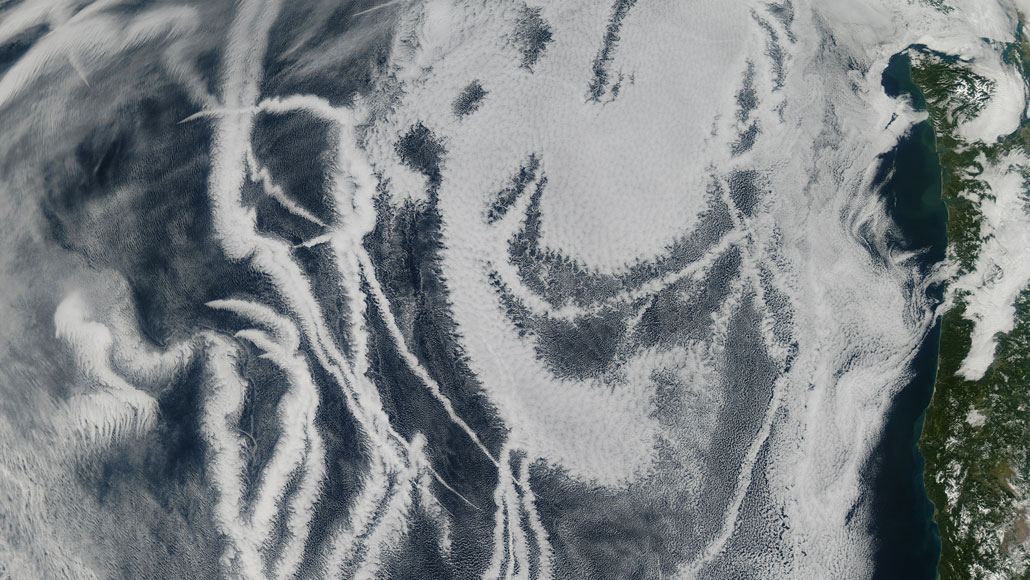
Interactions between aerosols from ship exhaust and clouds form “ship tracks,” shown here as bright white lines amid the clouds off the Pacific coast of North America.
NASA, GOES WEST
- More than 2 years ago
Among the biggest questions for climate change forecasters is how atmospheric aerosols shape clouds, which can help cool the planet. Now, a new study finds that one promising strategy for understanding how aerosols and clouds interact can overestimate the cooling ability of pollution-generated clouds by up to 200 percent, researchers report in the Jan. 29 Science.
“Clouds in general, and how aerosols interact with the climate, are a big uncertainty in climate models,” says Franziska Glassmeier, an atmospheric scientist at Delft University of Technology in the Netherlands. Scientists know that aerosols — both natural, as from volcanoes, and human-caused, as from pollution — can change a cloud’s thickness, ability to scatter sunlight or how much rainfall it produces. But these complicated physical effects are difficult to simulate, so scientists have sought real-world examples to study these effects.
Enter ship tracks. Exhaust belched out of massive cargo ships crossing the oceans can form these bright lines of clouds. The tiny exhaust particles act as cloud nuclei: Water vapor condenses on the particles to form cloud droplets, the watery stuff of clouds. Ship tracks are “this prime example where we can see this cause and effect,” Glassmeier says. “Put in particles, and you can see the clouds get brighter.” Brighter clouds means that they are reflecting even more sunlight back into space.
Visible and measurable by satellite, the tracks offer a potential window into how larger-scale industrial pollution around the globe might be altering the planet’s cloudscape — and perhaps how such clouds might affect the climate. Satellite-derived analyses of ship tracks involve measuring the density of the water droplets in the clouds from the images, and calculating how the brightness of the clouds changes over time.
To assess how well ship tracks actually represent the overall impact of pollution on clouds, Glassmeier and her colleagues compared the cooling effect of ship track clouds with that of simulated pollution-derived clouds, such as might occur over a city. In particular, the researchers wanted to simulate how both the thickness and the brightness of the clouds — and therefore their cooling effect — might evolve over time, as a result of processes like rainfall and evaporation.
The problem, the team found, is that the ship tracks don’t tell the whole story. Ship tracks are short-lived, because the source of pollution is always on the move. But industrial pollution doesn’t tend to happen in a brief pulse: Instead, there is a steady influx of particles to the atmosphere. And that difference in inputs affects how natural clouds respond over time.
In both the ship track studies and the simulations of industrial pollution, clouds initially brighten and produce a cooling effect. That’s because, in both cases, the addition of abundant aerosol particles to the atmosphere gives water vapor numerous surfaces on which to condense, creating many small water droplets that form this brighter cloud and reflect incoming radiation.
After a few hours, however, as a ship moves on, the ship track goes away, and the pulse of pollution ceases, Glassmeier says. The initial brief bit of cooling subsides as the preexisting natural clouds return to their original, nonpolluted state.
But in the case of industrial pollutants, the natural clouds don’t return to their original state, the simulations show. Rather, the pollutants hasten the clouds’ demise. That’s because the tinier aerosol-seeded droplets begin to evaporate more quickly than larger, natural cloud droplets would. This increased evaporation thins the original cloud, allowing more heat through than if the pollutants never arrived. And that can ultimately have an overall warming, rather than cooling, effect on the climate, the team says.
“There is this timescale effect that needs to be taken into account,” Glassmeier says. Relying solely on ship track data to understand all sources of pollution misses this gradual thinning effect. “I wouldn’t throw all the ship track data away; we just need to interpret it in a new way.” Current climate models tend to omit this thinning effect, she says.
The new study is “really useful for helping to interpret aerosol-cloud relationships in satellite data,” says Edward Gryspeerdt, an atmospheric physicist at Imperial College London who was not involved in the study. It “demonstrates that the cloud response to aerosols is not instant, but evolves over time.”
Scientists have been aware that ship tracks may not lead to cooling, says Graeme Stephens, an atmospheric scientist at NASA’s Jet Propulsion Laboratory in Pasadena, Calif. For example, Stephens notes that he and others have previously found that ship tracks can speed up cloud thinning by increasing the rate of evaporation at the tops of the clouds, while at the same time suppressing rainfall, which maintains some of the cloud’s thickness. These two competing responses make determining a cloud’s ultimate fate tricky.
But what ship tracks can do is act as “a controlled laboratory of sorts,” Stephens says. They “offer us a way to examine aerosol influences on clouds in a direct, concrete way.”







